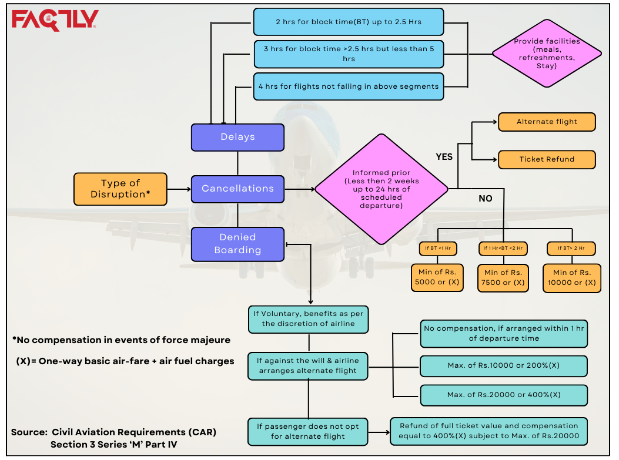The harsh weather in Delhi led to the cancellation of hundreds of flights in January 2024. Flight cancellations & delays pose a significant challenge for all those involved in the air transportation supply chain-passengers, airlines, airports, resulting in cascading effects. Data shows that the quantum of passengers affected by Flight delays & cancellations has reached pre-COVID levels.
Skies aren’t as friendly as they used to be: navigating them has turned into a rollercoaster ride for many. From unexpected delays to frustrating cancellations, this winter season has sent travel plans spiralling into chaos, leaving passengers stranded in departure lounges. The struggles faced by airlines have been amplified by harsh weather conditions, particularly in North India where a dense blanket of fog has engulfed the region. This has resulted in hundreds of flights being delayed and cancelled during January 2024, prompting the Directorate General of Civil Aviation (DGCA) to issue a new SoP for tackling flight delays.
Flight delays pose a significant issue for all those involved in the air transportation supply chain-passengers, airlines, airports, and air navigation service providers are among those affected by these delays. These delays also result in substantial economic losses. Given the tightly scheduled nature of air travel, even minor disruptions in the system have the potential to cascade and impact numerous other flights.
In today’s story, we look at the statistics related to airline delays, cancellations, and compensations in India.
Passenger protection measures for flight disruptions
As passenger traffic continues to grow, it’s crucial for the Government to strengthen the safety and rights of air travellers during flight disruptions like denied boardings, cancellations, and delays. It is important to enhance passenger protection standards to empower travellers and create a level playing field for airlines. According to Civil Aviation Requirement Section 3, Series M, Part IV, airlines are required to report on cases of denied boarding, cancellations, and delays, along with the status on a monthly basis, to ensure transparency and accountability.
Below is the indicative chart of the protection measures for passengers in cases of flight disruptions.

2023 saw record compensation being paid for flight disruptions.
The data on passengers affected by flight disruptions indicate the growing trend in the passengers affected by these disruptions. In 2014, around 4.2 lakh passengers were affected, which consistently grew to a record 33.2 lakh in 2019. Due to the onset of the pandemic in 2020 and its associated travel restrictions, the number of passengers affected by flight disruptions reduced to 8 lakhs in 2020. Since 2020, there has again been a consistent increase in the affected passengers, reaching 25.8 lakh in 2023, the second highest in the last decade.
Similarly, the airlines provide compensation and facilities wherever mandated to cope with flight disruptions. It is observed that in 2023, approximately Rs. 46.5 Crore was paid, surpassing the previous record of Rs. 46.1 Crore in 2017. Like the passengers affected, there has been a consistent rise in the compensation paid post-pandemic.
Delays accounted for more than 80% of the flight disruptions.
Among the types of air transport disruptions, the data indicates that passengers affected by delays beyond 2 hours account for approximately 84% of the total passengers affected, followed by cancellations at 15% and denied boarding at 1%. Interestingly, in terms of compensation, delays beyond 2 hours accounted for 43% of the total compensation, followed by denied boarding at 37%, and cancellations at 20%.
The year-wise trend on the passengers affected by disruptions shows that, in 2023, 3.1 lakh passengers were affected by cancellations, and 22.5 lakh passengers were affected by delays beyond 2 hours- both recording the second highest in this decade, after the highest in 2019 at 6.7 lakh passengers and 26 lakh passengers respectively. However, in terms of compensation offered, 2023 recorded the highest levels for both cancellations and delays beyond 2 hours at Rs. 9.9 Crore and Rs. 26.5 Crore respectively, beating their previous best of Rs. 8.2 Crore and Rs. 21.5 Crore respectively in 2019.
On an average, one of out every three cancellations are due to weather conditions in the last three years
Flight cancellations, though infrequent and challenging to anticipate, carry significant consequences when they do happen. The specific factors influencing which flights get cancelled remain somewhat elusive and likely differ among airlines. Technical factors, commercial factors, operational factors, and weather conditions are some of the major driving forces of airline cancellations.
The data on reason-wise cancellation rates show that weather emerges as a prominent factor behind cancellations. Between 2015 and 2019, on average, one out of every four cancellations (25%) were due to weather. This rose to more than 33%, meaning one out of every three cancellations was due to weather between 2021 and 2023.
This is a telling reminder that air travel is extremely sensitive to weather conditions and that the associated climate change is going to disrupt air travel significantly in coming years.
January is the most affected month in terms of the cancellation rates.
Unfavourable weather conditions elevate the likelihood of cancellations, as poor weather diminishes airport capacities, leading to extensive delays and cancellations. Parameters such as visibility, temperature, and wind speed, along with external conditions such as rain, thunderstorms, and snow being important aspects behind the determination of cancellations.
The data on seasonality show that rainy and winter seasons are most affected by flight cancellations. It can be seen that during the monsoon season, in whichever year the season went well, the cancellation rates are higher. Among the winter season months, January stands out with consistent cancellation rates across the years.
(Note: In 2020 & 2021, owing to COVID-19-related first and second waves, large-scale airline cancellations were done.)


